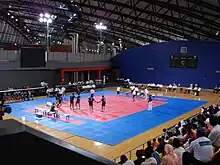
Kabaddi is a contact sport of South Asian origin which has many variations.[1]
Main disciplines
Standard style (Indoor)

In the international team version of kabaddi, two teams of seven members each occupy opposite halves of a court of 10 by 13 metres (33 ft × 43 ft) in case of men and 8 by 12 metres (26 ft × 39 ft) in case of women.[2] Each has five supplementary players held in reserve for substitution.[2] The game is played with 20-minute halves with a 5-minute half time break in which the teams exchange sides.[2] During each play, known as a "raid", a player from the attacking side, known as the "raider", runs into the opposing team's side of the court and attempts to tag as many of the seven defending players as possible. The raider must cross the baulk line into the defending team's territory, and then return to their half of the field without being tackled. (If an attacker touches a defender and hasn't yet reached the baulk line, they do not need to reach the baulk line to score points and may return to their half of the court.)[3] While raiding, the raider must loudly chant kabaddi, confirming to referees that their raid is done on a single breath without inhaling. Each raid has a 30-second time limit.[4][5][6][7]
A point is scored for each defender tagged; tags can be made with any part of the raider's body.[8] If the raider steps beyond the bonus line marked in the defending team's territory when there are six or more players, they earn an additional point known as a bonus point (the bonus point is only scored if the raider's trailing foot is in the air while they step over the line).[9] If the raider is successfully stopped (tackled), the opposite team earns a point instead. All players tagged are taken out of the game, but one is "revived" for each point a team scores from a subsequent tag or tackle. Bonus points do not revive players. Players who step out of the boundary are out. There are two strips on either side of the court known as "lobby areas"; they are part of the out-of-bounds area at the start of each raid, and only become part of the field of play once the raider touches an opponent.[9] A raid where no points are scored by the raider is referred to as an "empty raid". By contrast, a play where the raider scores three or more points is referred to as a "super raid". If a team gets all seven players on the opposing team out ("All Out"), they earn two additional points and the players are placed back in the game.[4][5][6][7]Punjabi style (Circle-style)
In the Punjab region, kabaddi is played on a circular[10] pitch of a diameter of 22 meters and an inner circle with a line through the middle of the pitch: the pitch is called . There are two teams of 8 players; one on one raid; and no player leaves the field.[11] If 2 stoppers attack a player, a foul is declared. Punjab style does not require the raider saying "kabaddi, kabaddi" throughout the raid.[10] The game lasts for 40 minutes with a change in sides after 20 minutes.[11]
In the Punjab Circle Style form of Kabaddi, whenever any player is touched (out), he does not go out of the court, but stays inside, and one point is awarded to the team that touched him. This game is also played on a time basis, i.e. the time is 30 sec.Variants of standard kabaddi
Beach kabaddi

Beach kabaddi is played in two 15-minute halves by two teams of four players who are not allowed to wear shoes.[12][13] It is played at an international level in competitions such as the Asian Beach Games.[14]
Ghoda kabaddi
Ghoda kabaddi is a variation of kabaddi in which one player on the offensive team (the ghoda or "horse") sits in a small circle deep within the defensive team's half of the field. Once touched by the raider, the horse can leave the circle and must then return to his team.[15][16][17][18]
Variants of circle kabaddi
Lambi kauddi
In lambi kauddi (Punjabi: لمبی کوڈی/ਲੰਬੀ ਕੌਡੀ)[11] there are 15 players with a circular pitch of 15–20 feet. There is no outer limit. The players can run as far they can. There is no referee. The raider will say "kauddi, kauddi" throughout the attack.
Saunchi kauddi
Saunchi kauddi (Punjabi: سانچی کوڈی/ਸੌਂਚੀ ਕੌਡੀ)[11] (also called Saunchi pakki/Punjabi: ਸੌਂਚੀ ਪੱਕੀ) can best be described as being similar to boxing. It is popular in the Malwa area of Punjab. It is unlimited players with a circular playing pitch. A bamboo with red cloth is dug into the ground which is paraded by the winner.
In sauchi kabaddi, the raider will hit the defender but only on the chest. The defender will then hold the raiders wrist. A foul is declared if any other part of the body is grabbed. If the defender holds the raiders wrist and restricts his movement, he will be declared the winner. If the raider loses the grip of the defender, then the raider will be the winner.[11]Other variants
Budhiya kabaddi
Budhiya kabaddi originates from the Magadha region of India.[19] It is played with two teams of four or more players. The scoring team has a player (called the budhiya or "old lady") who starts off positioned at the opposite end of the field from the "home" area. The old lady's goal is to reach home without being touched by any of the opponents.[15]
Goongi kabaddi
Slap kabaddi
Slap kabaddi or thappad kabaddi is a Pakistani variant of kabaddi which is particularly popular in Punjab.[21] Two players aim to slap each other, scoring one point for each slap landed on the opponent (above the waist);[22] the winner is the one who scores the most points, or who can force his opponent to forfeit the match.[23][24]
Punches are not allowed, though players can slam into each other.[25][26] There is no time limit or limit to the number of slaps that can be executed, though causing injury to the opponent results in disqualification in some matches.[27]Whip kabaddi
In whip kabaddi, one player (the singer) stands in one half of the court, while all other players stand on the other side of the court and each hold a whip-like object (generally made of a soft material like cloth or paper). The singer's job is to sing while trying to tag opponents; once the singer has tagged an opponent, they must flee the field and try to avoid being whipped.[28][29][30]
References
- ↑ Kabaddi, Star Sports Pro (2015-07-19). "Kabaddi: Rules and it's different formats". www.sportskeeda.com. Retrieved 2023-10-17.
- 1 2 3 Jha, Tarkesh. "Kabaddi: Origin, rules and the Pro Kabaddi League". Khel Now. Retrieved 24 January 2021.
- ↑ "Pro Kabaddi Rules". prokabaddi.com.
- 1 2 "Rules of Kabaddi". International Kabaddi Federation (IKF). Archived from the original on 4 March 2016. Retrieved 26 August 2014.
- 1 2 "Kabaddi World Cup 2016: A handy guide to the format, rules and how the sport works". Firstpost. 5 October 2016. Retrieved 29 October 2017.
- 1 2 Sengupta, Debdatta (27 July 2017). "Kabaddi 101: Raid, defend, revive, repeat". ESPN.com. Retrieved 29 October 2017.
- 1 2 Chandhok, Suhail (30 January 2016). "Everything you need to know about Kabaddi". The Indian Express. Retrieved 29 October 2017.
- ↑ "Move Over IPL, Pro-Kabaddi is Here to Stay". The New Indian Express. Retrieved 2023-10-15.
- 1 2 Kabaddi: How to play India’s 4000-year-old indigenous sport https://olympics.com/ Utathya Nag
- 1 2 Kissa Kabaddi da by Sarwan Singh Sangam Publications
- 1 2 3 4 5 Punjab Diyan Virasiti Kheda by Suhdev Maudhupuri. Chetna Parkashan
- ↑ "Beach Kabaddi held in Urmia". Tehran Times. 2018-10-05. Retrieved 2023-10-17.
- ↑ "Unsung champs of sand: India's women's beach kabaddi team". ESPN. 2017-03-29. Retrieved 2023-10-24.
- ↑ Newsroom, Por (2021-07-12). "Diversity of Sport Drives Asian Beach Games Program -- On the Scene". infobae (in European Spanish). Retrieved 2023-10-17.
- 1 2 Murari, Dr Mayank (2021-01-01). Jharkhand Ke Anjane Khel: Bestseller Book by Dr. Mayank Murari: Jharkhand Ke Anjane Khel (in Hindi). Prabhat Prakashan. ISBN 978-93-86870-65-0.
- ↑ रंग महोत्सव 2020 https://mdu.ac.in/
- ↑ अज्ञात (2018-11-01). खेल सृष्टि Khel Srishti. p. 33.
- ↑ Mishra ), डॉ महेन्द्र कुमार मिश्रा ( Dr Mahender Kumar (2022-01-15). सचित्र खेलकूद नियम ( Sachitra Khelkud Niyam ) (in Hindi). K.K. Publications.
- ↑ "Nalanda to showcase 'Budhiya Kabaddi' in a new avatar". The Times of India. 2011-02-06. ISSN 0971-8257. Retrieved 2023-10-21.
- ↑ "Amateur Circle Kabaddi Federation of India". Kabaddicircle.com. Retrieved 15 January 2018.
- ↑ "पाकिस्तान में अनोखा गेम, एक दूसरे को ताबड़तोड़ थप्पड़ मार रहे खिलाड़ी- VIDEO वायरल". आज तक (in Hindi). 2023-07-06. Retrieved 2023-10-17.
- ↑ "पाकिस्तान में खेली जाती है कुछ ख़ास किस्म की कबड्डी, जिसमें चलते हैं थप्पड़". BBC News हिंदी (in Hindi). 2023-06-22. Retrieved 2023-10-17.
- ↑ "What Is Thappad Kabaddi? This Variant Has Taken Internet By Storm". Zee News. Retrieved 2023-10-17.
- ↑ "Fact Check: Viral Slap Kabaddi video misidentified as Indian is from Pakistan". India Today. Retrieved 2023-10-17.
- ↑ "What Is Thappad Kabaddi? This Variant Has Taken Internet By Storm". Zee News. Retrieved 2023-10-17.
- ↑ "Slap Kabaddi, the viral sensation in Pakistan: Rules, Players, Origin, and More". SportsTiger. 2023. Retrieved 2023-10-17.
- ↑ "Watch | Videos of 'slap kabaddi' from Pakistan are going viral. But what is this sport?". WION. Retrieved 2023-10-17.
- ↑ LTD, MUKIL E. PUBLISHING & SOLUTIONS PVT (2022-08-21). குழந்தைகளுக்கான உடற்பயிற்சியும் விளையாட்டும். Mukil E Publishing And Solutions Private Limited.
- ↑ Journal of Health, Physical Education, Recreation. American Alliance for Health, Physical Education, and Recreation. 1960.
- ↑ Srivastava, Prof H. S. (2008). Manual For Schools. S. Chand. ISBN 978-81-219-2185-5.